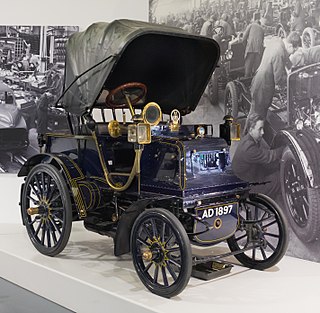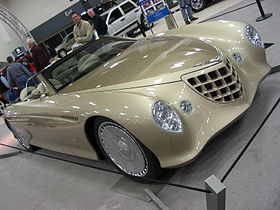
The Chrysler New Yorker is an automobile model produced by Chrysler from 1940 until 1996, serving for several decades as either the brand's flagship model or as a junior sedan to the Chrysler Imperial, the latter during the years in which the Imperial name was used within the Chrysler lineup rather than as a standalone brand.

The Chrysler Crossfire is a rear-wheel drive, two-seat sports car, marketed by Chrysler and manufactured by Karmann of Germany for the 2004 through 2008 model years.
There are many types of car body styles. They vary depending on intended use, market position, location, and the era they were made.

The Chrysler 300 is a full-size car manufactured and marketed by Stellantis North America and its predecessor companies as a four-door sedan and station wagon in its first generation and solely as a four-door sedan in its second generation.

The Plymouth Valiant is an automobile which was marketed by the Plymouth division of the Chrysler Corporation in the United States from the model years of 1960 through 1976. It was created to give the company an entry in the compact car market emerging in the late 1950s. The Valiant was also built and marketed, without the Plymouth brand, worldwide in countries including Argentina, Australia, Brazil, Canada, Finland, Mexico, New Zealand, South Africa, Sweden and Switzerland, as well as other countries in South America and Western Europe. It became well known for its excellent durability and reliability, and was one of Chrysler's best-selling automobiles during the 1960s and 1970s, helping to keep the company solvent during an economic downturn.

The Chrysler LeBaron, also known as the Imperial LeBaron, is a line of automobiles built by Chrysler from 1931 to 1941 and from 1955 to 1995. The model was introduced in 1931, with a body manufactured by LeBaron, and competed with other luxury cars of the era such as Lincoln and Packard. After purchasing LeBaron with its parent Briggs Manufacturing Company, Chrysler introduced the luxury make Imperial in 1955, and sold automobiles under the name Imperial LeBaron until 1975. Chrysler discontinued the Imperial brand in 1975, and reintroduced the Chrysler LeBaron in 1977 to what was then Chrysler's lowest priced model.

The Chrysler Concorde is a full-size car that was produced by Chrysler from 1992 to 2004. It assumed the C-body Chrysler New Yorker Salon's position as the entry-level full-size sedan in the Chrysler brand lineup. One of Chrysler's three original Chrysler LH platform models, it has a front-engine, front-wheel-drive layout.

The GMC Envoy is a mid-size SUV manufactured and marketed by General Motors for the 1998 to 2009 model years over two generations. Adopting a nameplate used by GM Canada, the Envoy was a rebadged variant of the Chevrolet TrailBlazer, Oldsmobile Bravada, Buick Rainier, Isuzu Ascender, and Saab 9-7X.

Three Chrysler Imperial Parade Phaetons were produced in 1952 by Chrysler as ceremonial vehicles. They were styled by Virgil Exner and were in many ways a preview of the new "100 Million Dollar" styling that would debut in 1955 on the newly separate Imperial marque and on other full-size Chrysler Corporation Cars.

The Chrysler Imperial, introduced in 1926, was Chrysler's top-of-the-line vehicle for much of its history. Models were produced with the Chrysler name until 1954, after which it became a standalone brand; and again from 1990 to 1993. The company positioned the cars as a prestige marque to rival Cadillac, Continental, Lincoln, Duesenberg, Pierce Arrow, Cord, and Packard. According to Antique Automobile, "The adjective 'imperial' according to Webster's Dictionary means sovereign, supreme, superior or of unusual size or excellence. The word imperial thus justly befits Chrysler's highest priced model."

The Buick Roadmaster is an automobile built by Buick from 1936 until 1942, from 1946 until 1958, and then again from 1991 until 1996. Roadmasters produced between 1936 and 1958 were built on Buick's longest non-limousine wheelbase and shared their basic structure with the entry-level Cadillac Series 65, the Buick Limited, and after 1940, the Oldsmobile 98. Between 1946 and 1957, the Roadmaster served as Buick's flagship.

The Chrysler Saratoga is an automobile built by Chrysler. The nameplate was used from 1939 to 1952 and from 1957 to 1960 in the U.S. market, in Canada through 1965, and in Europe from 1989 to 1995. In the beginning, it was introduced as a sport luxury model, using the Straight Eight engine from the Chrysler New Yorker which was more formal, and the Imperial which had graduated to special order limousine.

A phaeton is a style of open automobile without any fixed weather protection, which was popular from the 1900s until the 1930s. It is an automotive equivalent of the horse-drawn fast, lightweight phaeton carriage.

The Chrysler Town & Country is an automobile which was manufactured by Chrysler from 1940 to 1942 and from 1945 to 1988 with production interrupted during World War II. Primarily produced as a luxury station wagon, the Town & Country was also available in "woodie" four-door sedan, two-door hardtop and convertible body styles from 1947 to 1950, 1968 to 1969 and from 1983 to 1986. The 1988 model year was the last for the station wagon until the 1990 model year when Chrysler reintroduced the Town & Country nameplate as the rebadged variant Chrysler Town & Country minivan.
A glossary of terms relating to automotive design.

The Newport was a name used by Chrysler for both a hardtop body designation and also for its lowest priced model between 1961 and 1981. Chrysler first used the Newport name on a 1940 show car, of which five vehicles were produced. From 1950 to 1956, the Newport name was then used to designate any Chrysler model with a hardtop body style. In 1961, Chrysler introduced the Newport as a new, low-priced model, offering large, comfortable two- and four-door Chrysler models that were modestly priced compared with the Chrysler 300, the Chrysler New Yorker and the Imperial. For 1961, the Newport was priced below the Chrysler Windsor in the Windsor's final year.

The Cadillac Series 355 was a V8-powered luxury car manufactured by Cadillac from 1931 until 1935. It was offered as a 2-door club coupe, 2-door convertible, 4-door convertible, 4-door sedan, 4-door town car, and 4-door limousine. It provided a range of Cadillac below the maker's larger V-12 and V-16 lines. It was succeeded by the Cadillac Series 70/75.
The Audi R8 LMS Cup was a one-make sports car racing series by Audi based in Asia. Audi R8 LMS Cup cars were based on the Audi R8 LMS (GT3).

The Chrysler Six was a series of cars that were all installed with the Chrysler Straight Six when the company assumed operations of the Maxwell Automobile Company in 1924, and Chalmers Automobile Company in 1926. The Chrysler Six initially consisted of several Models, then Series designations that originally declared the approximate top speed each vehicle was able to consistently maintain, then each series number was incrementally updated every new model year, and each series was offered in several body style choices. The engines were technically advanced for their time and were entered in the 24 Hours of Le Mans for 1925, 1928 and 1929.

The third-generation Chrysler minivans are a series of passenger minivans that were marketed by the Chrysler Corporation from the 1996 to 2000 model years. The first ground-up redesign of the model lines since their introduction, designers added a further degree of divisional identity between the Plymouth Voyager, Dodge Caravan, and Chrysler Town & Country. In a notable change, the cargo van was discontinued, with all examples sold as passenger vans. Coinciding with the retirement of the Plymouth brand during 2001, this is the final generation marketed as the Plymouth Voyager.



















